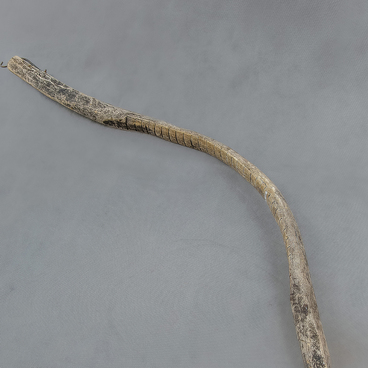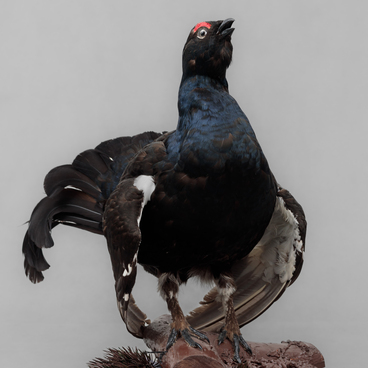Until the 18th century, people in Russia smoothed clothes with wooden devices called a “rubel” or a roll. They were corrugated boards. People wound dry linen on a roller and rolled it out. This made it possible to smooth the fabric and make it softer. They also used “gavki” — glass balls that were filled with hot water.
With the development of iron foundry production in the 18th century, the Demidov factories began to make the first cast-iron clothes irons. People heated them on the stove — the irons were quite efficient. Such devices were very heavy, as they ironed not only by heating clothes, but also by pressing with their weight.
The iron that is on display in the museum is a cast iron item. There are protrusions around the base that are 1 cm high and 2 mm wide. The handle of the iron is made of iron, not wood. The craftsman had it soldered to the iron. The maker’s mark was put on the top of the exhibit. The inscription is partially missing, but it is still readable and indicates the place of origin: the artel named after Kuibyshev in the Chelyabinsk region.
Women heated such irons on an open fire or in a hot oven. This tool continued to be produced until the 1960s. The cast-iron iron had to be warmed up for a very long time, at least half an hour, and it was impossible to use it without potholders. This led to the production of such products in pairs: with one removable handle for two cast-iron bases. While one base was used to iron, the second base was heated, and the ironing process was noticeably accelerated.
Large cast-iron irons weighed up to 10 kg and were intended for ironing coarse fabrics. To iron small elements, such as cuffs, collars or lace, as well as thin fabrics, housewives used small irons the size of half a palm.
The bottom of such irons got dirty from the fire, and women risked ruining the linen when ironing. If an iron was left on fire for a long time, its wooden handles could burn to ashes. Irons were passed down as heirloom from mother to daughter, and sometimes served as a strong argument in matchmaking. The mother instructed her daughter, “Go marry him, daughter, do not be stubborn, because there is an iron in that house.”
With the development of iron foundry production in the 18th century, the Demidov factories began to make the first cast-iron clothes irons. People heated them on the stove — the irons were quite efficient. Such devices were very heavy, as they ironed not only by heating clothes, but also by pressing with their weight.
The iron that is on display in the museum is a cast iron item. There are protrusions around the base that are 1 cm high and 2 mm wide. The handle of the iron is made of iron, not wood. The craftsman had it soldered to the iron. The maker’s mark was put on the top of the exhibit. The inscription is partially missing, but it is still readable and indicates the place of origin: the artel named after Kuibyshev in the Chelyabinsk region.
Women heated such irons on an open fire or in a hot oven. This tool continued to be produced until the 1960s. The cast-iron iron had to be warmed up for a very long time, at least half an hour, and it was impossible to use it without potholders. This led to the production of such products in pairs: with one removable handle for two cast-iron bases. While one base was used to iron, the second base was heated, and the ironing process was noticeably accelerated.
Large cast-iron irons weighed up to 10 kg and were intended for ironing coarse fabrics. To iron small elements, such as cuffs, collars or lace, as well as thin fabrics, housewives used small irons the size of half a palm.
The bottom of such irons got dirty from the fire, and women risked ruining the linen when ironing. If an iron was left on fire for a long time, its wooden handles could burn to ashes. Irons were passed down as heirloom from mother to daughter, and sometimes served as a strong argument in matchmaking. The mother instructed her daughter, “Go marry him, daughter, do not be stubborn, because there is an iron in that house.”





